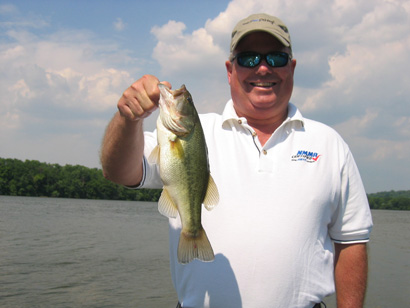NPO Profile: The NMMA Part 2
Category: article
Oct 28th, 2008 by OutdoorsFIRST
Modified Oct 28th, 2008 at 12:00 AM
BassFIRST continues today with Part 2 of the interview with NMMA President Thom Dammrich. He discusses the NMMA’s role in the future of boating and fishing, plus where he sees the future of sport boating and fishing heading in the US.
 |
|
|
NMMA President Thom Dammrich with a fishy friend (Photo NMMA)
|
BF – How many employees does your organization have?
TD – We have 140 employees in nine different cities.
BF – What role do you see for your organization in the future regarding sport fishing/boating?
TD – If NMMA didn’t exist, the industry would have to create it. The work we do in public policy advocacy and boating promotion, in industry statistics and certification are critical to the long term success of the industry. I like to say our members get full value for their dues just from the bad things we keep from happening to them, to say nothing of all the positive things we do for the industry.
BF – What is your personal fishing/boating background?
TD – I am a relatively new convert to boating and fishing. I enjoy cruising, bass fishing, fly fishing and deep sea fishing.
BF – Why are you the head of your organization?
TD – I assume it is because our members and board are confident in my leadership of the NMMA. Helping our members be successful is a passion for me. Helping to improve the boating experience so we can keep people in boating is a passion for me. I really believe that the work we do improves peoples’ quality of life by introducing them to the positive benefits of the boating lifestyle. That is very rewarding.
BF – Why should recreational anglers/boaters trust you to do right by them?
TD – I appreciate skepticism people might have, but NMMA is a very transparent organization. Much of what we do is focused on the boater, boating access and making boating more enjoyable. It is simply in our self interest as an industry to do right by our customers. That doesn’t mean individual boat owners won’t have issues with a manufacturer or dealer, but as each year passes I get fewer and fewer calls from consumers with problems. The industry is really focused on improving the boating experience.
BF – Where do you see the future of sport fishing/boating heading in the United States?
TD – According to the National Sporting Goods Association, participation in boating was up 6 percent in 2006 and up another 8.9 percent in 2007. Today about 30 percent of adult Americans go boating every year. About 70 percent of boats are used for fishing. In the next 40, years the U.S. population is expected to grow from 300 million people to 450 million people. If we do our job promoting boating, and we get 30 percent of them on the water, that will be nearly 50 million more people boating in 40 years. Many of them will be fishing, and it doesn’t take many to buy a new boat to create healthy growth for the industry. Our challenge is that most of the 150 million more Americans we expect to see over the next 40 years will be minorities. In fact, most of the 450 million people will be minorities. So, as an industry, we need to do a better job of helping minorities see themselves in boating and fishing. We need to see more minorities pictured in our brochures, our ads and in our magazines. We have to h
elp people see themselves in boating and fishing, and if we can do that, our future will be very bright.